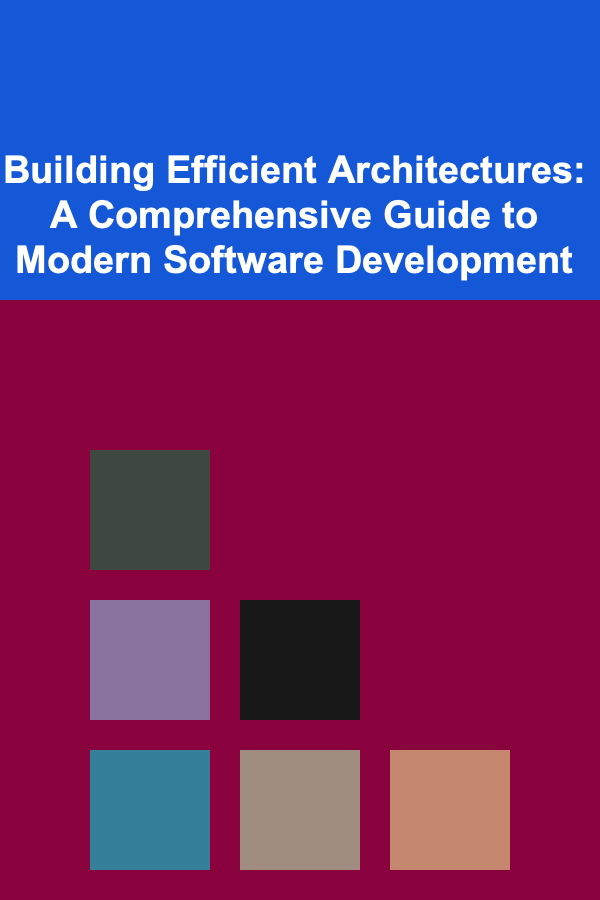
Building Efficient Architectures: A Comprehensive Guide to Modern Software Development
ebook include PDF & Audio bundle (Micro Guide)
$12.99$10.99
Limited Time Offer! Order within the next:

In modern software development, creating an efficient architecture is crucial to the success of any application. As systems grow in complexity, it's easy to get lost in the details, especially with the constant push towards faster delivery and continuous innovation. However, designing an efficient architecture requires careful planning, deep understanding, and a strategic approach.
This guide explores the core principles, techniques, and strategies for building efficient software architectures in today's fast-paced development environment. It addresses key challenges and provides actionable steps for tackling these issues to create robust, scalable, and maintainable systems.
The Importance of Efficient Software Architectures
At the heart of every successful software application is a well-designed architecture. It is the skeleton on which the entire system operates, influencing performance, scalability, maintainability, and overall user experience. Efficient architectures ensure that the system can handle future growth, adapt to changing requirements, and mitigate risks related to technology choices.
Key benefits of efficient software architecture include:
- Scalability: As demand increases, an efficient architecture can scale horizontally or vertically to meet the needs without major re-architecture.
- Maintainability: Well-structured systems are easier to modify, fix bugs in, and add features to, which leads to lower long-term maintenance costs.
- Performance: Proper architectural decisions can help optimize resource usage, minimize latency, and improve overall application responsiveness.
- Resilience: A resilient architecture can withstand failures gracefully, ensuring minimal disruption to users.
Key Principles of Efficient Software Architecture
1. Simplicity Over Complexity
One of the foundational principles in software design is the principle of simplicity. An efficient architecture minimizes unnecessary complexity. While it can be tempting to design highly intricate systems to solve every edge case, a simpler design is often easier to maintain and extend.
Key actions to simplify your architecture:
- Favor clear, small components: Break down your system into manageable pieces, each with a clear purpose.
- Use standard design patterns: Reusable patterns like Model-View-Controller (MVC), Factory, and Singleton can help reduce complexity while solving common problems.
- Avoid over-engineering: Design for current requirements, but leave room for future growth instead of trying to predict every possible use case.
2. Modularity
A modular approach to software architecture helps in creating independent, reusable components that can be developed, tested, and deployed separately. Modularity reduces interdependencies, making the system easier to manage and scale.
Key actions to achieve modularity:
- Microservices: If appropriate, consider using a microservices architecture where each service is loosely coupled and performs a distinct function. Microservices promote independence, easier debugging, and scaling.
- Layered Architecture: Use layers to separate concerns such as presentation, business logic, and data access. Each layer interacts with only the adjacent layer, reducing dependencies.
- Domain-Driven Design (DDD): Apply DDD principles to break the system into bounded contexts that map directly to business domains, reducing complexity within each domain.
3. Scalability
An efficient architecture must be able to scale as the application grows. Scalability is both horizontal (adding more machines) and vertical (upgrading hardware). By planning for scalability, you ensure the system can handle increased loads without significant performance degradation.
Key actions to ensure scalability:
- Decouple Components: Minimize direct dependencies between services and components. For example, asynchronous messaging (such as event-driven architecture or message queues) can decouple systems and improve scalability.
- Use Distributed Systems: Leverage distributed computing technologies like cloud services, container orchestration (e.g., Kubernetes), and database sharding to scale horizontally.
- Performance Optimization: Profile your application early to identify potential bottlenecks and optimize critical code paths to avoid scalability issues.
4. Resilience and Fault Tolerance
Fault tolerance ensures that the system can continue to function even in the event of partial failures. Building resilience into your architecture reduces downtime and enhances user experience.
Key actions for building resilience:
- Redundancy: Create redundancy at every level (servers, databases, networking) to minimize single points of failure.
- Graceful Degradation: Implement fallback mechanisms so that if one part of the system fails, the user experience is not entirely disrupted.
- Distributed Data: Use replication and partitioning strategies for databases to ensure data availability and minimize the impact of system failures.
5. Maintainability
An efficient architecture supports long-term maintainability. As business needs evolve, the software must evolve too. The easier it is to make changes, the less time and cost it will take to adapt the system to new requirements.
Key actions for maintainability:
- Code Modularity: Write clean, modular code that follows SOLID principles to ensure that changes are localized and don't ripple through the system.
- Automation: Implement automated testing, continuous integration/continuous deployment (CI/CD) pipelines, and monitoring. This helps catch issues early and ensures quick rollbacks in case of failure.
- Clear Documentation: Document key architectural decisions, service interactions, and data flows. This helps developers understand the system's structure and makes it easier for new team members to onboard.
6. Security
Security is non-negotiable in modern software architectures. An efficient architecture should include security considerations at every level to protect data and users from malicious attacks.
Key actions to ensure security:
- Secure Communication: Use HTTPS for secure communication between components and encrypt sensitive data both in transit and at rest.
- Authentication and Authorization: Implement robust authentication and authorization mechanisms. Tools like OAuth, OpenID, or SSO (Single Sign-On) help manage user access securely.
- Security Audits: Regularly audit your architecture for potential vulnerabilities and apply patches as soon as security flaws are discovered.
Key Architectural Styles and Approaches
While there is no one-size-fits-all solution for software architecture, there are several popular architectural styles that can be adapted to create efficient systems. Let's explore some of the most common and powerful ones.
Microservices Architecture
Microservices is an architectural style that divides a system into a set of loosely coupled, independently deployable services. Each service focuses on a specific business capability and communicates with others using lightweight protocols like HTTP or messaging queues.
- Advantages: Easier to scale, independent deployments, failure isolation, and flexibility in technology stack.
- Challenges: Increased operational complexity, potential for data consistency issues, and managing service communication.
Event-Driven Architecture (EDA)
Event-driven architecture is based on the concept of emitting and reacting to events. Components of the system produce events that other components consume asynchronously. This approach can be particularly useful in systems that require high scalability and responsiveness.
- Advantages: Loose coupling, scalability, real-time processing, and flexibility.
- Challenges: Complex event flow management, handling eventual consistency, and increased difficulty in debugging.
Serverless Architecture
Serverless computing allows developers to build and run applications without managing infrastructure. Instead of provisioning servers, developers write functions that are executed on-demand in response to specific events.
- Advantages: No server management, automatic scaling, cost-efficiency (you only pay for execution time).
- Challenges: Cold start issues, limited execution time, and vendor lock-in with cloud providers.
Layered Architecture
In a layered architecture, the system is divided into layers, where each layer has a specific responsibility, such as the presentation layer, business logic layer, and data access layer. This structure promotes separation of concerns and modularity.
- Advantages: Clear separation of concerns, easier to maintain, and reusable components.
- Challenges: Overhead in communication between layers, and it can become cumbersome if not managed correctly.
Best Practices for Efficient Architecture
1. Embrace Domain-Driven Design (DDD)
Domain-Driven Design helps you align the architecture with business needs. It encourages the use of a shared language between developers and business experts, resulting in a system that directly reflects the problem domain.
2. Keep Your System Extensible
Design your system with future changes in mind. Use abstraction layers, interfaces, and pluggable components so that new features can be added without major rewrites.
3. Monitor and Measure
Continuously monitor system performance, user behavior, and error rates. Use metrics and logs to detect issues early and improve your architecture based on real data.
4. Iterate Over Time
Architecture is not a one-time task. As business needs evolve, so should your architecture. Make incremental changes over time rather than attempting a massive redesign.
5. Use the Right Tools and Technologies
Choose tools and technologies that suit your team's skills and your system's requirements. Avoid chasing every new trend---focus on tools that solve your specific challenges effectively.
Conclusion
Building an efficient architecture requires a thoughtful and systematic approach to design. From maintaining simplicity and modularity to ensuring scalability, resilience, and security, each decision you make shapes the future of the application. By embracing core principles, understanding the most appropriate architectural styles, and following best practices, you can create software systems that are robust, scalable, and adaptable to the challenges of tomorrow.
Ultimately, efficiency in software architecture is about balancing current needs with future flexibility, ensuring your system can grow and evolve as business demands change.

Ethics: Guidelines for Moral Decision-Making
Read More
How to Choose the Right Printing Method for Your T-Shirt Designs
Read More
How to Keep Your Home Clean After Bringing Your Pet Outdoors
Read More
How to Launch a Website Development Service for Small Business Owners
Read More
How to Maintain Records of Past Tenant History
Read More
What Tips Can You Use for Organizing Your Home Gym?
Read MoreOther Products

Ethics: Guidelines for Moral Decision-Making
Read More
How to Choose the Right Printing Method for Your T-Shirt Designs
Read More
How to Keep Your Home Clean After Bringing Your Pet Outdoors
Read More
How to Launch a Website Development Service for Small Business Owners
Read More
How to Maintain Records of Past Tenant History
Read More